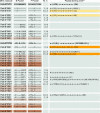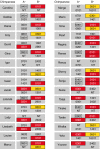AIDS-protective HLA-B*27/B*57 and chimpanzee MHC class I molecules target analogous conserved areas of HIV-1/SIVcpz
- PMID: 20696916
- PMCID: PMC2930537
- DOI: 10.1073/pnas.1009136107
AIDS-protective HLA-B*27/B*57 and chimpanzee MHC class I molecules target analogous conserved areas of HIV-1/SIVcpz
Abstract
In the absence of treatment, most HIV-1-infected humans develop AIDS. However, a minority are long-term nonprogressors, and resistance is associated with the presence of particular HLA-B*27/B*57 molecules. In contrast, most HIV-1-infected chimpanzees do not contract AIDS. In comparison with humans, chimpanzees experienced an ancient selective sweep affecting the MHC class I repertoire. We have determined the peptide-binding properties of frequent chimpanzee MHC class I molecules, and show that, like HLA-B*27/B*57, they target similar conserved areas of HIV-1/SIV(cpz). In addition, many animals appear to possess multiple molecules targeting various conserved areas of the HIV-1/SIV(cpz) Gag protein, a quantitative aspect of the immune response that may further minimize the chance of viral escape. The functional characteristics of the contemporary chimpanzee MHC repertoire suggest that the selective sweep was caused by a lentiviral pandemic.
Conflict of interest statement
The authors declare no conflict of interest.
Figures





Similar articles
-
The HLA A03 Supertype and Several Pan Species Major Histocompatibility Complex Class I A Allotypes Share a Preference for Binding Positively Charged Residues in the F Pocket: Implications for Controlling Retroviral Infections.J Virol. 2020 Apr 16;94(9):e01960-19. doi: 10.1128/JVI.01960-19. Print 2020 Apr 16. J Virol. 2020. PMID: 32075930 Free PMC article.
-
Conserved CTL epitopes shared between HIV-infected human long-term survivors and chimpanzees.J Immunol. 1999 Feb 15;162(4):2308-14. J Immunol. 1999. PMID: 9973508
-
Major histocompatibility complex class I diversity in a West African chimpanzee population: implications for HIV research.Immunogenetics. 2000 May;51(6):398-409. doi: 10.1007/s002510050638. Immunogenetics. 2000. PMID: 10866106
-
The HIV-1 pandemic: does the selective sweep in chimpanzees mirror humankind's future?Retrovirology. 2013 May 24;10:53. doi: 10.1186/1742-4690-10-53. Retrovirology. 2013. PMID: 23705941 Free PMC article. Review.
-
Progression of HIV to AIDS: a protective role for HLA-B27?AIDS Rev. 2004 Apr-Jun;6(2):89-96. AIDS Rev. 2004. PMID: 15332431 Review.
Cited by
-
Signature Patterns of MHC Diversity in Three Gombe Communities of Wild Chimpanzees Reflect Fitness in Reproduction and Immune Defense against SIVcpz.PLoS Biol. 2015 May 28;13(5):e1002144. doi: 10.1371/journal.pbio.1002144. eCollection 2015 May. PLoS Biol. 2015. PMID: 26020813 Free PMC article.
-
Bonobos Maintain Immune System Diversity with Three Functional Types of MHC-B.J Immunol. 2017 May 1;198(9):3480-3493. doi: 10.4049/jimmunol.1601955. Epub 2017 Mar 27. J Immunol. 2017. PMID: 28348269 Free PMC article.
-
Although divergent in residues of the peptide binding site, conserved chimpanzee Patr-AL and polymorphic human HLA-A*02 have overlapping peptide-binding repertoires.J Immunol. 2011 Feb 1;186(3):1575-88. doi: 10.4049/jimmunol.1002990. Epub 2011 Jan 5. J Immunol. 2011. PMID: 21209280 Free PMC article.
-
The KIR repertoire of a West African chimpanzee population is characterized by limited gene, allele, and haplotype variation.Front Immunol. 2023 Dec 11;14:1308316. doi: 10.3389/fimmu.2023.1308316. eCollection 2023. Front Immunol. 2023. PMID: 38149259 Free PMC article.
-
Unique peptide-binding motif for Mamu-B*037:01: an MHC class I allele common to Indian and Chinese rhesus macaques.Immunogenetics. 2013 Dec;65(12):897-900. doi: 10.1007/s00251-013-0734-5. Epub 2013 Sep 17. Immunogenetics. 2013. PMID: 24042460
References
-
- Fujiyama A, et al. Construction and analysis of a human-chimpanzee comparative clone map. Science. 2002;295:131–134. - PubMed
-
- Hahn BH, Shaw GM, De Cock KM, Sharp PM. AIDS as a zoonosis: Scientific and public health implications. Science. 2000;287:607–614. - PubMed
-
- Santiago ML, et al. SIVcpz in wild chimpanzees. Science. 2002;295:465. - PubMed
Publication types
MeSH terms
Substances
LinkOut - more resources
Full Text Sources
Medical
Research Materials

